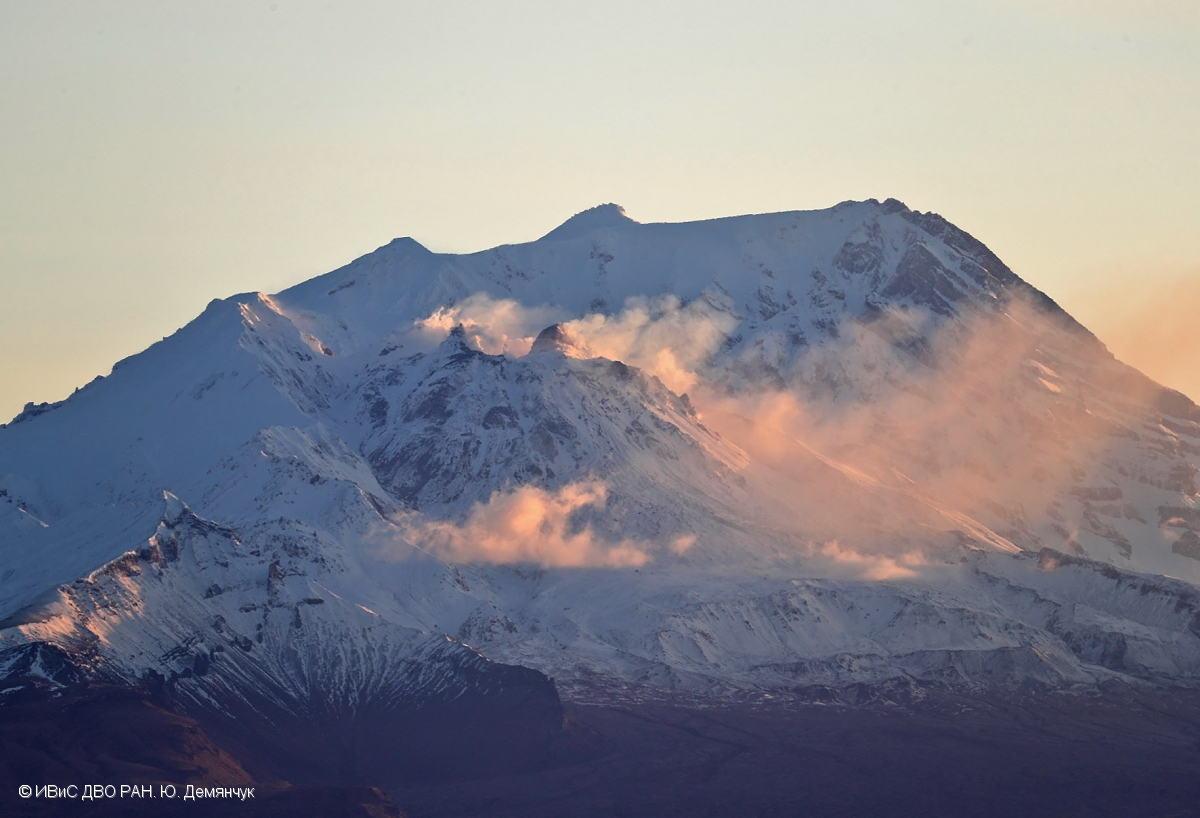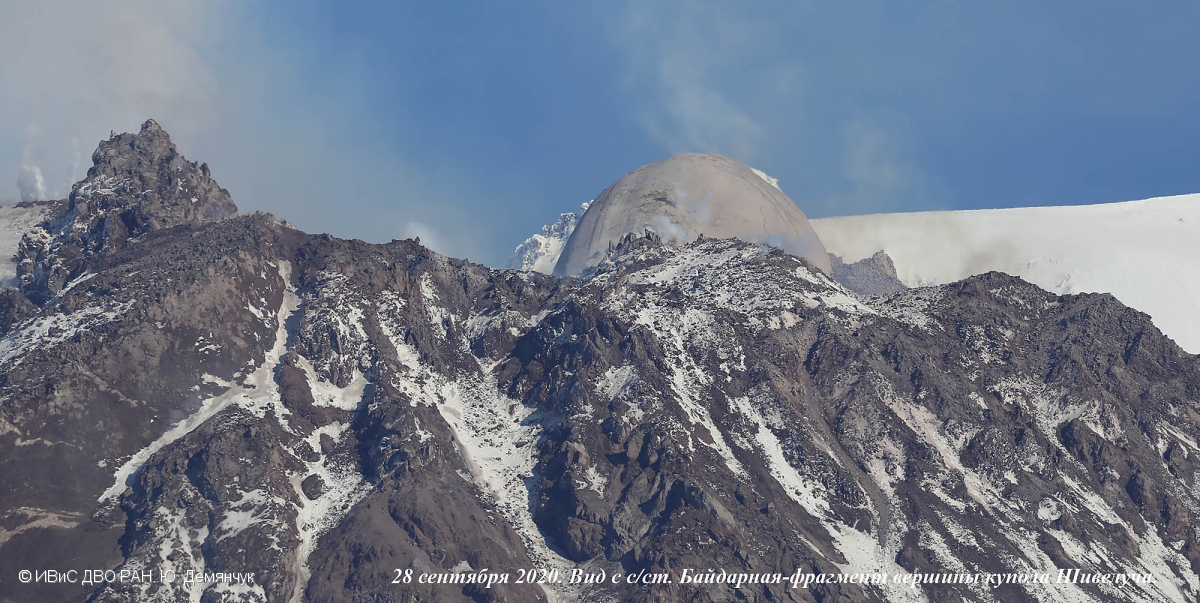Report on Sheveluch (Russia) — November 2020
Bulletin of the Global Volcanism Network, vol. 45, no. 11 (November 2020)
Managing Editor: Edward Venzke.
Research and preparation by Paul Berger.
Sheveluch (Russia) New whaleback dome extruded in late September 2020; intermittent explosions
Please cite this report as:
Global Volcanism Program, 2020. Report on Sheveluch (Russia) (Venzke, E., ed.). Bulletin of the Global Volcanism Network, 45:11. Smithsonian Institution. https://doi.org/10.5479/si.GVP.BGVN202011-300270
Sheveluch
Russia
56.653°N, 161.36°E; summit elev. 3283 m
All times are local (unless otherwise noted)
The ongoing eruption at Sheveluch continued during May-October 2020, characterized by lava dome growth, strong fumarolic activity, and several explosions that generated plumes of resuspended ash. Activity waned between November 2019 and April 2020 (BGVN 45:05), and this less intense level of activity continued during the reporting period (table 15). The volcano is monitored by the Kamchatka Volcanic Eruptions Response Team (KVERT). The Aviation Color Code remained at Orange (the second highest level on a four-color scale) throughout.
Notable explosions took place on 13 June, 28 June, 2 August, 24 August, and 7-9 October 2020 (table 15), sending ash plumes more than 1 km above the summit that drifted to distances of between 75 and 310 km. Some of the plumes were described by KVERT as being composed of re-suspended ash. On 28 September a large dacitic block of lava, a “whaleback” dome, was first seen being extruded from the eastern part of the larger lava dome in the summit crater (figure 55); it was given the name “Dolphin” by KVERT.
Table 15. Explosions, ash plumes, and extrusive activity at Sheveluch during May-October 2020. Dates and times are UTC, not local. VONA is Volcano Observatory Notice for Aviation. Data courtesy of KVERT and the Tokyo Volcanic Ash Advisory Center (VAAC).
| Dates | Plume altitude | Drift Distance and Direction | Remarks |
| 13 Jun 2020 | 5 km | 120 km NE | Webcam captured an explosion. VONA issued. |
| 28 Jun 2020 | -- | 140 km E | Plume of re-suspended ash. VONA issued. |
| 02 Aug 2020 | 4.5 km | SE, E | Moderate explosion produced a small ash plume. |
| 24 Aug 2020 | -- | 75 km ESE | Plume of resuspended ash. |
| 28 Sep 2020 | -- | -- | A new lava block extruded from the E part of the lava dome was first visible. |
| 07-09 Oct 2020 | -- | 310 km SE | Plume of re-suspended ash. VONAs issued. |
According to KVERT, a thermal anomaly was identified from the lava dome in the summit crater (figure 56) in satellite images every day during the reporting period, except for several days in August and September when weather clouds obscured the view. During the reporting period, thermal anomalies, based on MODIS satellite instruments analyzed using the MODVOLC algorithm, recorded hotspots from 2-13 days per month; after June, the number of days with hotspots gradually diminished every month. The MIROVA (Middle InfraRed Observation of Volcanic Activity) volcano hotspot detection system, also based on analysis of MODIS data, detected frequent anomalies. NASA recorded high levels of sulfur dioxide above or near Sheveluch during several scattered days in May and June by the TROPOspheric Monitoring Instrument (TROPOMI) aboard the Copernicus Sentinel-5 Precursor satellite, but very little drift was observed.
 |
Figure 56. Photo showing typical fumarolic activity from the lava dome at Sheveluch on 18 September 2020. Photo by Yu. Demyanchuk; courtesy of IVS FEB RAS, KVERT. |
Geological Summary. The high, isolated massif of Sheveluch volcano (also spelled Shiveluch) rises above the lowlands NNE of the Kliuchevskaya volcano group. The 1,300 km3 andesitic volcano is one of Kamchatka's largest and most active volcanic structures, with at least 60 large eruptions during the Holocene. The summit of roughly 65,000-year-old Stary Shiveluch is truncated by a broad 9-km-wide late-Pleistocene caldera breached to the south. Many lava domes occur on its outer flanks. The Molodoy Shiveluch lava dome complex was constructed during the Holocene within the large open caldera; Holocene lava dome extrusion also took place on the flanks of Stary Shiveluch. Widespread tephra layers from these eruptions have provided valuable time markers for dating volcanic events in Kamchatka. Frequent collapses of dome complexes, most recently in 1964, have produced debris avalanches whose deposits cover much of the floor of the breached caldera.
Information Contacts: Kamchatka Volcanic Eruptions Response Team (KVERT), Far Eastern Branch, Russian Academy of Sciences, 9 Piip Blvd., Petropavlovsk-Kamchatsky, 683006, Russia (URL: http://www.kscnet.ru/ivs/kvert/); Institute of Volcanology and Seismology, Far Eastern Branch, Russian Academy of Sciences (IVS FEB RAS), 9 Piip Blvd., Petropavlovsk-Kamchatsky 683006, Russia (URL: http://www.kscnet.ru/ivs/eng/); Tokyo Volcanic Ash Advisory Center (VAAC), 1-3-4 Otemachi, Chiyoda-ku, Tokyo, Japan (URL: http://ds.data.jma.go.jp/svd/vaac/data/); Hawai'i Institute of Geophysics and Planetology (HIGP) - MODVOLC Thermal Alerts System, School of Ocean and Earth Science and Technology (SOEST), Univ. of Hawai'i, 2525 Correa Road, Honolulu, HI 96822, USA (URL: http://modis.higp.hawaii.edu/); MIROVA (Middle InfraRed Observation of Volcanic Activity), a collaborative project between the Universities of Turin and Florence (Italy) supported by the Centre for Volcanic Risk of the Italian Civil Protection Department (URL: http://www.mirovaweb.it/); Global Sulfur Dioxide Monitoring Page, Atmospheric Chemistry and Dynamics Laboratory, NASA Goddard Space Flight Center (NASA/GSFC), 8800 Greenbelt Road, Goddard, Maryland, USA (URL: https://so2.gsfc.nasa.gov/).


